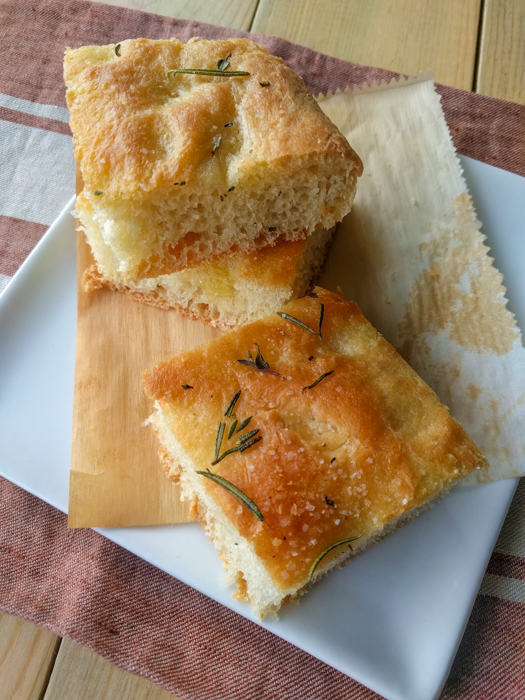 Who doesn’t love focaccia? A leavened flat bread with seemingly unlimited variations, everyone can find a favorite. This season as we visited Vicenza on a cycling tour and later on a walking tour we made focaccia with a true Italian chef. Prep took 10 minutes max, two hours to rise, then bake and we had ourselves a real treat, focaccia fresh from the oven, topped simply with rosemary and olive oil.
Who doesn’t love focaccia? A leavened flat bread with seemingly unlimited variations, everyone can find a favorite. This season as we visited Vicenza on a cycling tour and later on a walking tour we made focaccia with a true Italian chef. Prep took 10 minutes max, two hours to rise, then bake and we had ourselves a real treat, focaccia fresh from the oven, topped simply with rosemary and olive oil.
Focaccia bread originated thousands of years ago in Ancient Rome. Called panis focacius, it was a leavened flat bread baked on the hearth, or focus. The basic recipe is thought by some to have originated with the Etruscans or ancient Greeks.
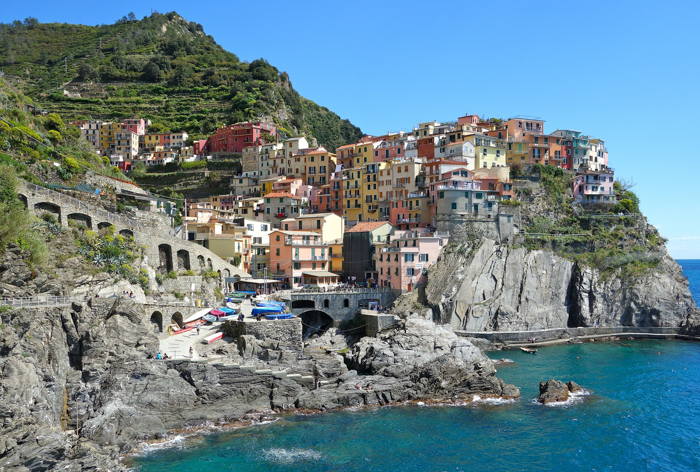 Today focaccia is found throughout the Italian peninsula, but it is primarily associated with Ligurian cuisine, as the olive oil in the bread helps keep it from spoiling quickly in the salt air and humidity of this coastal region. As we enjoy a walking tour in Cinque Terre, we visit many small towns that dot the coast of Liguria, each isolated and each with their own variation this flat bread. Focaccia Genovese is the most common, topped simply with a mixture of olive oil and water, and salt. It is enjoyed throughout the day, for breakfast with your cappuccino, as an afternoon snack, or in the dinner bread basket.
Today focaccia is found throughout the Italian peninsula, but it is primarily associated with Ligurian cuisine, as the olive oil in the bread helps keep it from spoiling quickly in the salt air and humidity of this coastal region. As we enjoy a walking tour in Cinque Terre, we visit many small towns that dot the coast of Liguria, each isolated and each with their own variation this flat bread. Focaccia Genovese is the most common, topped simply with a mixture of olive oil and water, and salt. It is enjoyed throughout the day, for breakfast with your cappuccino, as an afternoon snack, or in the dinner bread basket.
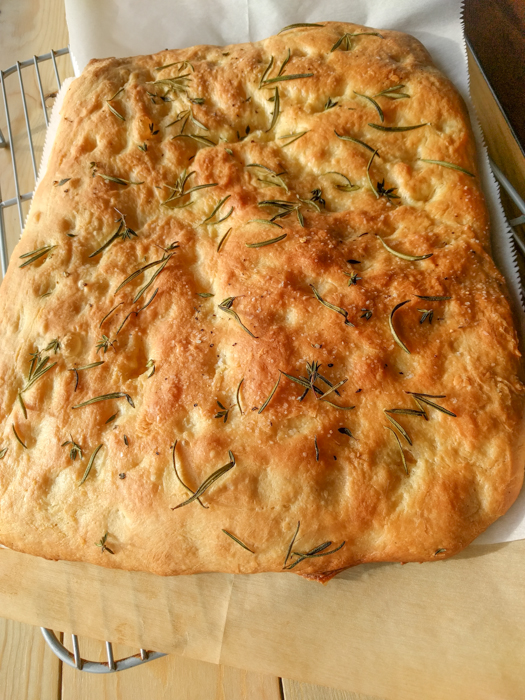 Some versions are fluffy and cake-like, thanks to a bit of potato in the dough. The other extreme may be the Focaccia col Formaggio (“focaccia with cheese”) from Recco, near Genoa. This version bears little resemblance to what we know as focaccia, consisting of a cheese filling sandwiched between two layers of paper-thin dough. It is being considered for European Union PGI status.
Some versions are fluffy and cake-like, thanks to a bit of potato in the dough. The other extreme may be the Focaccia col Formaggio (“focaccia with cheese”) from Recco, near Genoa. This version bears little resemblance to what we know as focaccia, consisting of a cheese filling sandwiched between two layers of paper-thin dough. It is being considered for European Union PGI status.
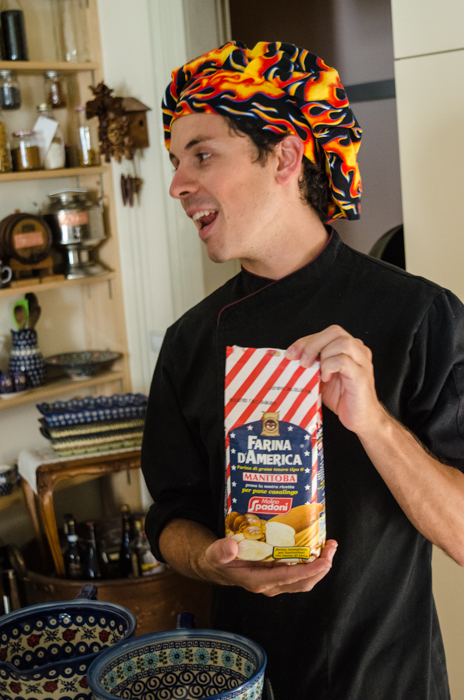 Below is the recipe we made with Luca in our cooking classes (here is a link to Lucas’ web site.) I like to discuss with our Italian chefs the differences between ingredients we find in Italy and those we’ll find back in the US, so our guests can recreate the experience back in their own kitchen. Typical Italian flour “00” is made from softer wheat than our all purpose flour, and is very fine. It is not ideal for bread. In Italy, the best flour for bread making actually comes from Manitoba, Canada. Luca points out that the importers of this product seem to think, however, that Manitoba is in the US, as they call it Farina d’America and package it in red, white and blue stars and stripes. Back home in the USA, it turns out quite well with either all purpose flour or bread flour.
Below is the recipe we made with Luca in our cooking classes (here is a link to Lucas’ web site.) I like to discuss with our Italian chefs the differences between ingredients we find in Italy and those we’ll find back in the US, so our guests can recreate the experience back in their own kitchen. Typical Italian flour “00” is made from softer wheat than our all purpose flour, and is very fine. It is not ideal for bread. In Italy, the best flour for bread making actually comes from Manitoba, Canada. Luca points out that the importers of this product seem to think, however, that Manitoba is in the US, as they call it Farina d’America and package it in red, white and blue stars and stripes. Back home in the USA, it turns out quite well with either all purpose flour or bread flour.
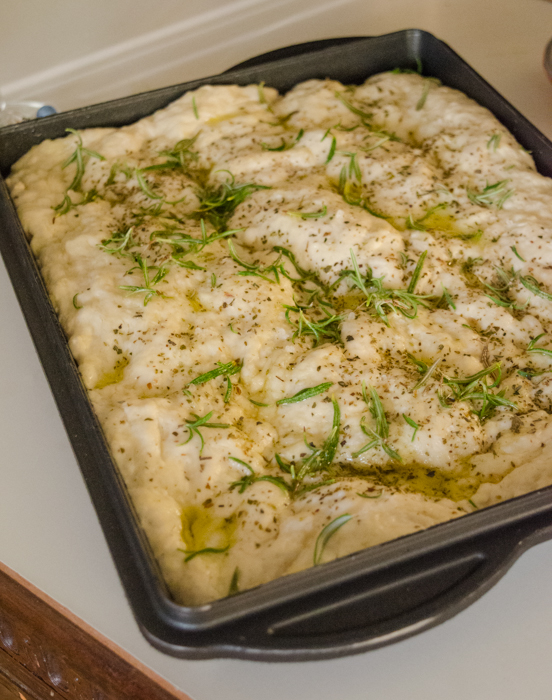 Focaccia con Rosemarino
Focaccia con Rosemarino
1 package dry yeast (2 1/4 teaspoons)
1 tablespoon of sugar (optional)
1 cup of warm water
2 cups of bread flour
1/2 cup of olive oil
1 1/2 tablespoon kosher salt
Rosemary
Oregano
Pepper
In a big bowl, dissolve the yeast and the sugar in the warm water. If you have not used your yeast recently, you may want to test it to make sure it is still active – to do this, dissolve it in just a couple of tablespoons of the water and allow to sit for 10 minutes or so. If it is bubbling a bit at the end of the 10 minutes, add the rest of the water and continue. If not bubbling, you need new yeast!
Add 1 1/2 cups of the flour and 1 tablespoon of the salt into the bowl, and with a strong wood spoon, mix the water into the flour. Continue to mix for about 1-2 minutes.
Add the other 1/2 cup of flour and mix to form a stiff dough. Knead the focaccia dough in the bowl for about 3 minutes, mixing very well. Add 1/3 cup of olive oil to the dough. Using your hands, squeeze the olive oil into the dough for about a minute. Any extra oil a the bottom of the bowl you will later pour on the top of the dough.
Make a ball with the dough, and put the dough in a sheet pan lined with a sheet of parchment paper. Spread the dough with your hands into rectangle, about 1/2 inch thick.
Using your fingers, make little indentations all over the dough – this is what they do in Genova! Pour the rest of the olive oil on the top of this, the oil will pool and fill the small holes you made with your fingers. Cover with plastic wrap and let the focaccia rise for about two hours.
Preheat the oven to 400°F.
I sometimes repeat the poking of the dough after the rise, if the indentations have disappeared during the rise, and perhaps add a bit more olive oil. Sprinkle with the remaining salt, the rosemary, the oregano and the pepper. Bake for about 30 – 40 minutes, until nicely golden brown. Keep your eye on the bread so it doesn’t over bake and turn into a rock. Enjoy!!
